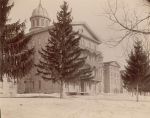Difference between revisions of "Portal:Featured Article Of The Week"
M-Explorer (talk | contribs) |
M-Explorer (talk | contribs) (Undo revision 45060 by M-Explorer (talk)) |
||
| (157 intermediate revisions by the same user not shown) | |||
| Line 1: | Line 1: | ||
{{FAformat | {{FAformat | ||
| − | |Title= | + | |Title= Mendota Mental Health Institute |
| − | |Image= | + | |Image= Mendota03.jpg |
|Width= 150px | |Width= 150px | ||
| − | |Body= | + | |Body= Mendota opened on July 14, 1860, when it admitted a patient who had been brought from Oconto County...a long trip by horse and wagon. Even though the hospital was not yet ready to open, that Saturday, it was decided that, because of the distance the patient had been brought, he should be received. Thus began Mendota's ready response to the needs of patients and communities, which has been its tradition. |
| − | + | Mendota has undergone significant changes since then, some of which are reflected in the changes to its name. It opened as an "Asylum", appropriate in an era when little could be done for the mentally ill except to house and care for them...i.e. to give them asylum...when their families and communities could no longer cope with their needs. [[Mendota Mental Health Institute|Click here for more...]] | |
| − | |||
| − | |||
}} | }} | ||
Latest revision as of 10:36, 3 August 2025
Featured Article Of The Week
Mendota Mental Health Institute
Mendota opened on July 14, 1860, when it admitted a patient who had been brought from Oconto County...a long trip by horse and wagon. Even though the hospital was not yet ready to open, that Saturday, it was decided that, because of the distance the patient had been brought, he should be received. Thus began Mendota's ready response to the needs of patients and communities, which has been its tradition.
Mendota has undergone significant changes since then, some of which are reflected in the changes to its name. It opened as an "Asylum", appropriate in an era when little could be done for the mentally ill except to house and care for them...i.e. to give them asylum...when their families and communities could no longer cope with their needs. Click here for more...
